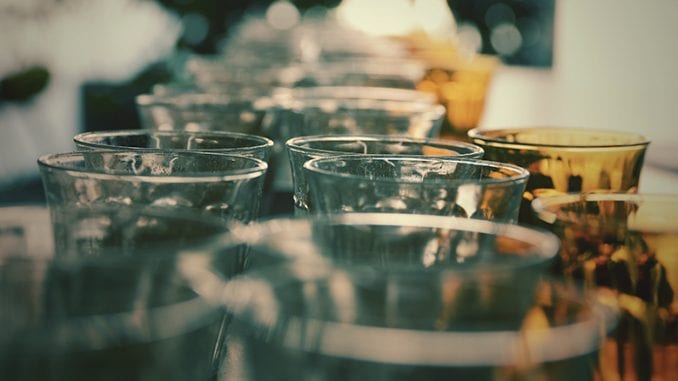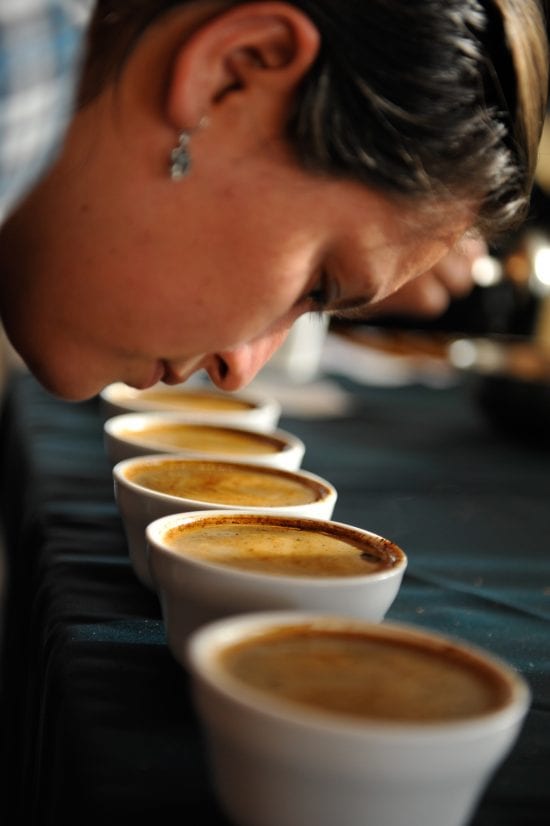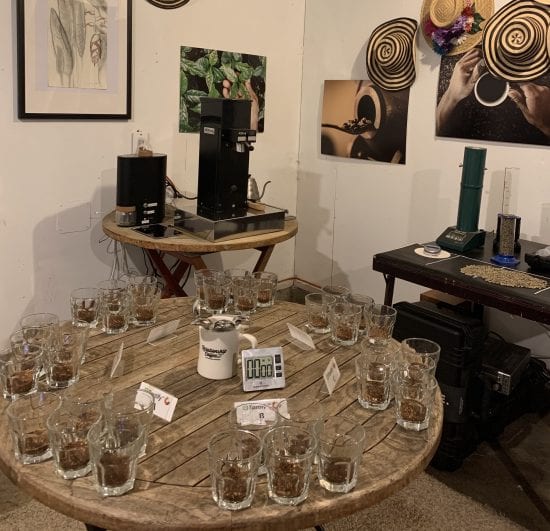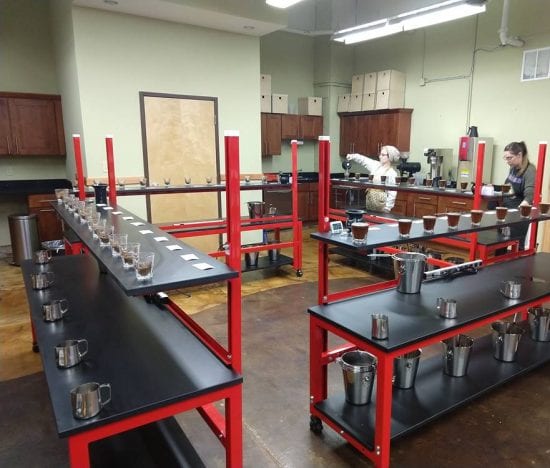
We talk to several coffee companies about how they’ve adapted their practices for evaluating coffee during the pandemic.
BY CHRIS RYAN
BARISTA MAGAZINE ONLINE
Cover photo courtesy of Alliance For Coffee Excellence
Coffee professionals who have spent time in the cupping room know it’s largely a communal experience: Cuppers take turns dipping their spoon into shared cups, slurping the spoonfuls to evaluate the coffee. Though it’s customary to plunge the spoons into water between spoonfuls to rinse them off, the traditional cupping practice leaves room for improvement when evaluated from a sanitary perspective.
In mid-2020, as we view everything through the lens of the COVID-19 pandemic, we are thinking about sanitary practices more than ever—and, no surprise, coffee professionals are changing their cupping protocols accordingly. Coffee businesses’ responses to how they cup is perhaps a microcosm of how many things in our lives have been altered: rapidly, with updates to how we handle it as more information comes in. Here is a snapshot of how some coffee pros’ approaches to cupping had evolved when we talked to them in May.

The Specialty Coffee Association (SCA) responded to the pandemic in March by releasing the Modified SCA Cupping Protocol, which involved cuppers having individual shot glasses to spoon their samples into and taste—this kept cuppers from dipping their used spoon into the same samples, as no one was tasting from their spoons. Peter Giuliano, chief research officer of the SCA, says he heard from many cuppers this spring using the new protocol, but he also discovered that batch brewing was rising in popularity as a coffee evaluation tool. “We realized that in many instances, batch brewing is a totally workable substitute for cupping in many group settings,” Peter says, “and in fact has some distinct advantages, including that tasting properly batch-brewed coffee resembles better the consumer experience of coffee drinking, which is of great importance!”
Peter says that while very few people are cupping in groups right now due to the pandemic, some who are cupping alone are still using the modified protocol to get used to it, since cupping will likely look different as coffee professionals readjust to the practice as they return from the pandemic. “I think everyone is much more aware of disease transmission than we used to be, and people are embracing the ‘new’ cupping protocol as a sort of new best practice,” he says.
Talking to different coffee evaluators, it’s clear they’re taking various approaches, many of which are continuing to evolve. At Noble Coyote Coffee Roasters in Dallas, co-owner Kevin Sprague says they started using the SCA’s modified cupping protocol in March, including having a public cupping early in the month with participants adopting the protocol. But as the pandemic has gone on, they’ve settled into different methods. “We’ve found it easier to just have our team members cup individually using their own set of bowls and spoons rather than sharing,” Kevin says. “And if it’s just one coffee we’re assessing, then pouring a V60 and splitting it among the team is not only easier, but also gives us a chance to share a cup of coffee together.”
At Stumptown Coffee Roasters in Portland, Ore., for the past two months the two-person quality control team—quality control manager Craig O’Lander and green coffee sourcing manager Katy Keisling—have divided their time in the lab, each spending two solo days there per week. The first day is spent receiving, cataloging, and roasting green samples, while day two is spent cupping and communicating results. “So far we’ve been able to stay on top of things and keep the flow of coffee moving along, but ultimately it’s not an ideal setup,” Craig says. “I think we’re all looking forward to getting back to some form of normalcy in the not-too-distant future.”
Craig says this unusual situation has helped he and Katy see how well-calibrated they are, and that close communication about the coffees has been key to navigating cupping separately. However, he says things will likely change once they resume work after the pandemic. “Now that we’re cupping solo it’s essentially a standard cupping protocol with some serious clean-up and disinfecting afterwards,” he says. “Once we start to ease back into a more normal situation we’ll absolutely be altering our cupping approach accordingly. Paying so much extra attention to hygiene these days has really highlighted how potentially unhygienic cupping can be.”

On the importing side, Sustainable Harvest in Portland has been cupping remotely since March. Yimara Martinez, the company’s quality control manager, established a cupping lab in her garage, and Sustainable Harvest’s coffee evaluators around the world stay calibrated through digital tools, including their in-house app, Tastify. “We had been building digital tools for quality control well before the pandemic, so we were well equipped for remote tasting,” says Alfonso Carmona, Sustainable Harvest’s chief marketing officer. “We were fast to pivot and adapt to 100% remote work to protect the health of our employees around the globe.”
Another importer, Minneapolis-based Cafe Imports, was already thinking about an isolated approach to the sensory experience of cupping—before the pandemic hit—in an effort to maintain consistency in coffee evaluation, and it has since furthered that approach. “Stepping into a sample prep cycle in our lab in December of 2019 already looked like a naïve version of a COVID response protocol (sans absolute distancing, masks, and disinfecting),” says Ian Fretheim, director of sensory analysis for Cafe Imports. “With COVID we’ve changed more in degree than in kind [and] taken things further, like adding mask wearing and regular disinfecting. We’ve also really focused on distancing such that now we come to the office in shifts, and within the office itself we each operate separate parts of the sample life cycle.”

Ian says Cafe Imports’ evaluation form, scoring standards and much of their presentation protocols have not changed, but they’ve adapted new evaluation standards, including each cupper having their own table with the same coffees as the other cuppers, each sample presented with one cup, and each table being cupped alone. “This kind of time and space distancing is, on some level, what we really want in terms of being able to dig in and work independently, with as little distraction as possible,” Ian says, before adding, “to be clear, I miss everyone very badly and can’t wait to see you all in person, hugs.”
The pandemic has caused people in countless industries to adapt their practices with safety in mind, and specialty coffee is no different. It remains to be seen how cupping will look post-COVID-19, but it’s likely that cuppers will apply many lessons and practices from this time in their labs going forward.

